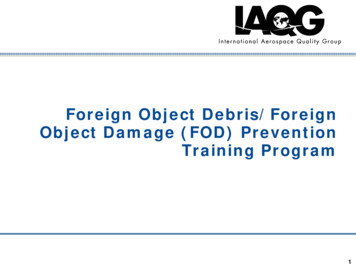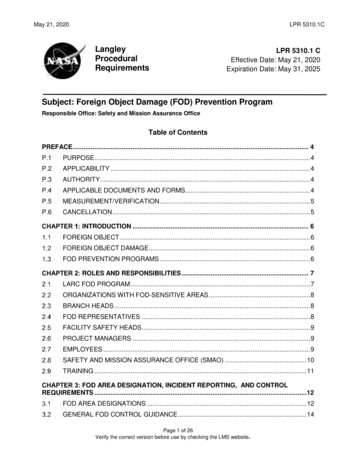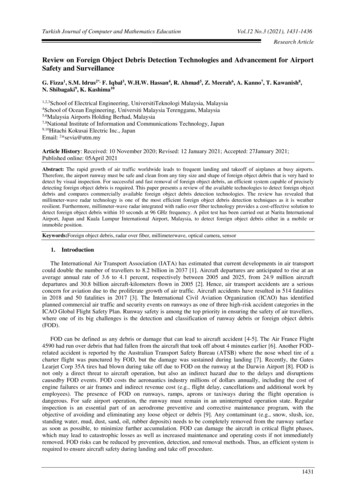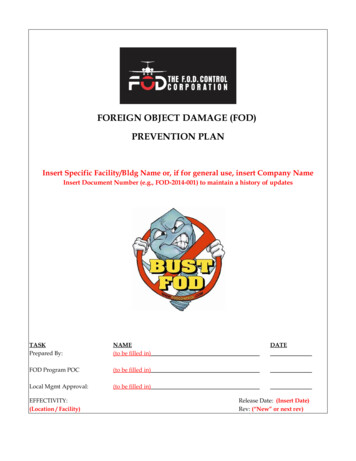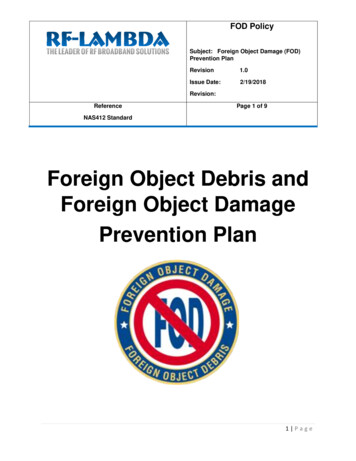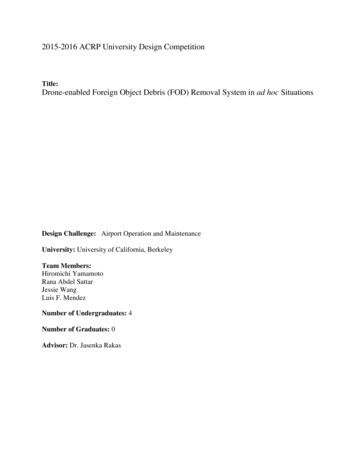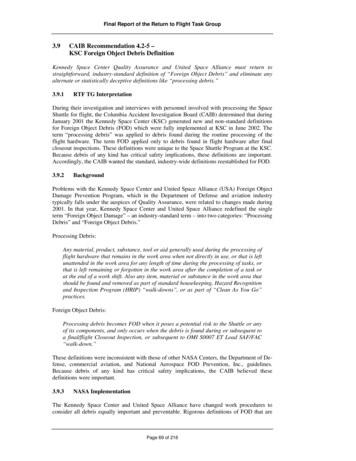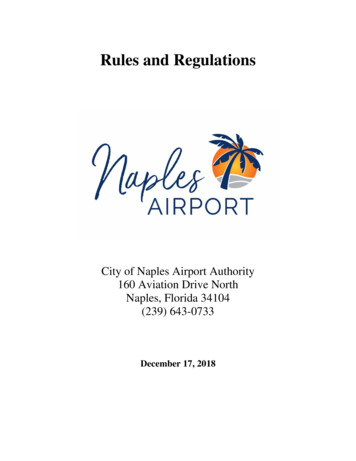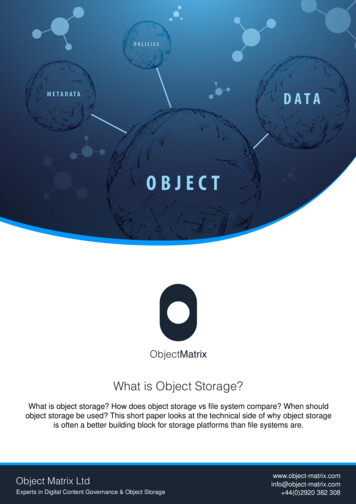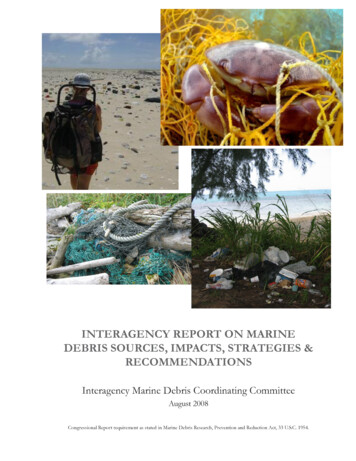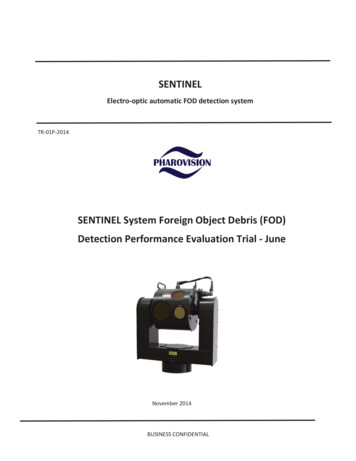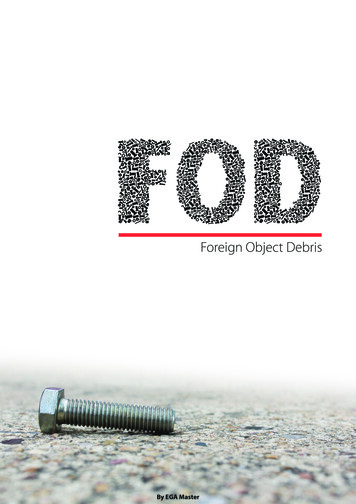
Transcription
Foreign Object DebrisBy EGA Master
A world developing exponentially fastpushes the most demanding industriesto call for more efficient tool control andsafety systems.That is why EGA Master has developeda wide range of tool control systems toavoid risks such as FOD.2FODForeign Object Debris
FODForeign Object Debris3
1WHAT IS FOD?Foreign object debris (FOD) at airports includes anyobject in an inappropriate location that may damageequipment or injure staff. FOD includes a wide range ofmaterials: loose hardware, pavement fragments, cateringsupplies, building materials, stones, sand, suitcases and evenwildlife. The FOD can be found at terminal gates, loadingplatforms, taxiways, runways and boarding platforms.The three main areas that require special attention are:Runway FOD: It refers to various objects (dropped fromaircraft or vehicles, broken ground equipment, birds, etc.)that are present on a runway and that may adversely affecta moving aircraft (during takeoff and landing). The runwayFOD has the greatest potential to cause damages.Taxiway and/or platform FOD: While this type of FODmay seem less harmful than the previous one, it should benoted that the jet generated by the reactors can easily throwsmall objects onto the track.Maintenance FOD: It refers to various objects, such as tools,materials or small parts used in maintenance activities (e.g.aircraft maintenance, construction work, etc.) and may causedamage to aircraft.4FODForeign Object DebrisThe three mainareas that requirespecial attentionare: runwayFOD, taxiway orplatform FOD andmaintenance FOD
2WHATEFFECTS CANFOD HAVE?FOD can cause damages in several ways, the most importantbeing: Damaging aircraft engines if swallowed.Cracking aircraft tires.Blocking aircraft mechanisms that prevent them fromoperating properly.Injuries to people after being propelled by the jet of thereactors.It is estimated that the damages generated cost theaerospace industry 4 billion euros a year.It is estimatedthat the damagesgenerated costthe aerospaceindustry 4 billioneuros a yearFODForeign Object Debris5
3FODTAXONOMYThe nature of FOD is also varied. FOD can be composedof any material and can be of any color and size.In an airport study conducted over a year (French Studyinformation paper on automatic FOD detection systems- EUROCONTROL Workshop, 9-10 June 2008), more than60% of the FOD elements collected were made of metal,followed by 18% that were rubber. Dark-colored items madeup almost 50% of the FOD collected.The typical FOD includes the following:6 Aircraft parts and engines (nuts, bolts, washers, safetycables, etc.). Aircraft parts (fuel caps, landing gear fragments, hydraulicbars, metal sheets and tire fragments). Hand tools. Catering supplies. Airline elements (nails, staff badges, pens, pencils,luggage tags, soft cans, etc.). Platform items (paper and plastic catering scraps andcargo pallets, luggage pieces and debris). Runway and taxiway materials (concrete and asphaltpieces, rubber gaskets and paint chips). Construction waste (pieces of wood, stones, fastenersand other metal objects). Plastic and/or polyethylene materials. Natural materials (plant fragments, wildlife and volcanicash). Snow or ice in winter.FODForeign Object DebrisThe nature ofFOD is alsovaried. FOD canbe composed ofany material andcan be of any colorand size
4WHAT FACTORSCONTRIBUTETO FOD? Poor maintenance of buildings, equipment and aircraft. Inadequate staff training. Stressing the staff that lead to a worse inspection. Climate (e.g., FOD can be generated by strong winds; orits detection may be hampered by adverse weather). Presence of uncontrolled vehicles (e.g. contractors) atthe aerodrome.FODForeign Object Debris7
5HOW TOCOMBATFOD?A successful FOD management program generally containsfour main areas, each of which contains significant elements,as described below:Prevention Awareness (existence of FOD program and managementsupport) Training and education (implementation of the FODprogram) maintenanceDetection Operations (human inspections and use of detectionequipment) EquipmentElimination Equipment OperationsEvaluation Data collection and analysis Continuous improvement (trends, comments, incidentinvestigation)Means to combat FOD include the following activities:8 Regular and frequent inspection of the aerodrome,including aircraft maneuvering areas and adjacent openspaces. Suspension of runway operations after notification tothe competent authority of FOD “on” or “near” the trackuntil the FOD has been removed and the track has beeninspected as necessary. Regular and frequent inspection of aerodrome buildingsand equipment and immediate repair or recall of itemsthat can create FOD. Inspection of the parking door to make sure it is FOD-FODForeign Object DebrisA successful FODmanagementprogram generallycontains four mainareas; prevention,detection,elimination andevaluation
free, including ground equipment, and ice, snow, orother material capable of reducing braking action. Removing FOD as soon as it is identified. Use of constant inspection systems (explained in thefollowing chapter). Implementation of a FOD control program (explained inthe following chapter).FODForeign Object Debris9
6CONSTANTINSPECTIONSYSTEMSConstant inspection systems use a combination ofradar and electro-optical sensors that facilitate thedetection of FOD 24/7 in any weather conditions.These systems are used in some of the world’s busiestairfields, including Heathrow, Vancouver, Dubai, Doha andothers.The benefits of this system on conventional vehicleinspections are: Constant monitoring, including night and low visibilityconditions. FOD detection is faster and more reliable. More efficient traffic flow (uninterrupted by inspections). Reduced risk of track incursions (by inspection vehicle,for example, due to driver error). Reduced risk of bird strokes (optical sensors recognizebirds).Constant inspectionsystems use acombination ofradar and electrooptical sensorsthat facilitate thedetection of FOD24/7 in any weatherconditions10FODForeign Object Debris
7FODCONTROLPROGRAM1. CONSCIOUSNESSA. Existence and status of the programA first step in implementing a successful FOD managementprogram is to ensure that staff know about the existence ofthe program. The FOD management system of an airportmust be visible in all areas of the operation of the airport.FOD safety exercises will occur more efficiently if all airportstaff are actively encouraged to identify potential FODhazards, act to eliminate them, and propose solutions tomitigate those hazards. Some organizational communicationmeans are: FOD seminars. FOD letters, notices and newsletters. Sharing learned lessons. FOD bulletin boards, security reporting mailboxes, andelectronic reporting via websites or email. Methods of exchanging security-related informationwith other airport operators through regional offices orprofessional organizations. FOD program promotional materials: t-shirts, caps, etc. Discussing FOD at employee staff meetings.B. FOD policy and management supportAn effective FOD program should have management’s fullsupport. Management’s commitment to FOD preventionmust be formally expressed in the organization’s policy.The declaration will serve to formally establish the FODmanagement program. Publishing this policy statementin visible places will help reinforce the organization’scommitment to FOD prevention and remind employees oftheir FOD management duties. Key elements of an airport’sFOD policy are: A summary of the methods and processes that theorganization will use to achieve desired securityoutcomes.A first step inimplementing asuccessful FODmanagementprogram is toensure that staffknow about theexistence of theprogramFODForeign Object Debris11
The organization’s policy regarding accountability andresponsibility.The FOD program managerA.Airport operators must appoint a responsiblestaff member to manage the airport’s FOD programs andproblems. The designated person can be a fully dedicatedFOD administrator or may have other tasks (e.g. operationsmanager, security manager, etc.).B.The responsibilities of the FOD Manager should beclearly defined along lines of communication identified withinthe organization. In addition, the FOD manager should beallowed to report to the highest levels of management (e.g.airport president, CEO, etc.) to ensure proper considerationof all reports, recommendations and issues.C.The FOD manager should periodically communicatethe status of the FOD program to airport staff and ensurethat the learned lessons from hazardous case investigationsor experiences, both internally and from other organizations,are widely distributed. There must always be an open andavailable line between the FOD Manager and the airport/aircarrier staff.The FOD CommitteeA.Several airports of different sizes and complexitieshave found it useful to establish a FOD committee. Note: Thelevel of authority or power of the FOD committee will bedifferent for each airport, as it is established by the executivedirection of the airport.B.The composition of the committee is the airport’schoice, but it is typical that the members of the committeeinclude all those with a direct relationship with FOD (such asthose in a position to produce or eliminate FOD): air carriers,operations and public safety personnel, representativesof contractors, etc. The FOD manager usually chairs thecommittee.12FODForeign Object DebrisAirport operatorsmust appoint aresponsible staffmember to managethe airport’s FODprograms andproblems
C.One of the most important functions of the FODcommittee is to serve as a resource for the FOD manager.In addition, the determination of potentially dangerous FODsituations can be established by the FOD committee, as wellas perform an evaluation of data collected from FOD.Safety CultureAn effective FOD management program requires more thanjust implementing rules and procedures to follow. It requiresthe support of management to establish the attitude,decisions and methods of operation of the policies thatdemonstrate the prevalence of safety for the organization.In effective safety cultures, there are clear reporting lines,clearly defined duties and easy-to-understand procedures.The staff must fully understand its responsibilities andknow what to report, to whom and when. Critical aspectsof a safety program are appropriate personal attitudes andcorporate commitment to enable and facilitate the removalof unsafe elements.An airport FOD control program is most effective whenaddressing four main areas:TrainingAll airport and airline personnel must be trained in theidentification and disposal of FOD, including possibleconsequences of ignoring it. FOD training for flight crewsinclude procedures identified in the Flight Crew OperationManual, pre- and post-flight inspection procedures. Trainingincludes procedures for identifying and removing FOD atits source and should be strengthened through the use ofposters and signs.Continuous training is needed to help maintain a FODawareness.InspectionIt must be carried out by the staff of the airlines, airport andaircraft managements agencies. Airline staff, when feasible,All airport andairline personnelmust be trained inthe identificationand disposal ofFODFODForeign Object Debris13
must join airport staff in daily inspections. This practicehelps to increase familiarity with local airfield conditions andpromotes effective communication between the airport andairlines.The International Civil Aviation Organization (ICAO) requiresa daily, daylight inspection of the areas of aircraft manoeuvrefor the elimination of FOD. In addition to performing theseinspections at the beginning of the day or shift, staff in theboarding area should look for FOD during their normal shifts.Ongoing construction works require more frequentinspections. It may be necessary to assign dedicatedpersonnel to continuously inspect the FOD during majorconstruction activities.Flight crews must inform air traffic control and stationoperations of any FODs they observe on runways andtaxiways. Aircraft operators and handling agents must14FODForeign Object DebrisAirline staff,when feasible,must join airportstaff in dailyinspections
designate persons to inspect aircraft parking posts prior tomovement.Maintenance Sweep: This can be done manually or with a sweeper, whichis the most effective equipment to eliminate the FOD. Thesweeper removes debris from cracks and pavement joints.It should be used in all areas except those that can only bereached with a manual broom. All areas exposed to the aircreated by the engines, including the aircraft maneuveringareas, the doors and the areas adjacent to them, should beroutinely swept. Areas where the ground support teamworkshould be swept periodically. Magnetic bars: These can be suspended under vehiclesto collect metallic material. However, the bars should becleaned regularly to prevent the collected waste fromfalling again, by creating new FOD. Vehicles operating in theFODForeign Object Debris15
boarding area should be inspected periodically to ensurethat they do not have loose parts that can be detached. Soundtracks: Rumbling strips can detach the FOD fromthe bottom of the vehicles. The strips, which are between3 and 5 meters long, are portable and can be in transitionsfrom the ground zone to the air zone, or adjacent to theconstruction areas of the air zone. FOD containers: Must be placed in all doors for collectingdebris. Containers must be emptied frequently to preventthem from overflowing and becoming a FOD source. Inaddition, airport staff can use bags at the waist to collectdebris. Assessing waste collected in containers and bagshelps identify their sources and indicate where personneland equipment should be deployed for more effectivecontrol.Other means of preventing FOD damage include windbarriers and nets to restrict FOD movement in the air,fences to prevent animals from entering the airfield andwell-maintained paved surfaces. If the damaged pavementcannot be repaired immediately, the aircraft must use analternative route.CoordinationAirports with a FOD committee tend to control FOD moresuccessfully than those without it.At airports served by several airlines, they must have theirown representatives and an airport user committee tocoordinate FOD control efforts between them.Both construction activities in the land and air area as wellas scheduled maintenance, should be communicated toairport users as soon as possible. Pre-construction planningof the airport should include a means of controlling andcontaining the FODs generated by the construction. This isespecially important in highly windy environments wherewaste is more likely to be transported into the air. Accessto and from construction sites should avoid using aircraft16FODForeign Object Debris
operation areas. Contractors must fully understand therequirements and penalties incorporated in their contractswith respect to FOD control and elimination.Airports with aFOD committeetend to controlFOD moresuccessfully thanthose without itFODForeign Object Debris17
8STANDARD NAS 412TOOL CONTROL MEASURES1. Inventory: Analyze the tools that are stored andtransported to the workplace to eliminate all unnecessarytools that may be the cause of FOD.2. Count and identify: Count sets/kits and identify themwith the name or number of the operator, to ensurethat the tools are counted before and after use (toollisting, storage and return distribution systems, controlsoftware.)3. Use containers to transport the necessary toolsexclusively.4. Unique tagged location for each tool. Inventorytool control and automatic mapping systems arerecommended.5. Service and condition: procedures to check andensure the proper condition of tools and equipment,safely eliminating those that are broken, worn or in nonoptimal conditions.6. Missing Tool Report: An anonymous reporting systemmust be established to ensure tool loss reporting.7. Responsibility and control of tools: appropriate useof containers, tool inventory process, tool use inspectionprocedures, ensuring availability and cleaning, control ofelements and equipment and procedures for lost items/tools; marking, bicolor trays or panels, control and usagelog.8. Tool status control and cleaning. An inspectionshould be carried out before and after using the tools,checking any rebars, part loss, loose parts, fractures orchips.9. Limit tools quantity to the minimum required forthe job. Avoid migrating tools between areas. The toolsmust comply with the return-to-warehouse processbefore being moved to a new area.10. Employing workstations for tool storage and control.18FODForeign Object Debris
11. Control consumables (tapes, glue-sticks, compounds,etc.)12. When visual inspection cannot be carried out withminimal handling of the product on which it is worked,other inspecting systems such as mirrors, UVflashlights, borescopes, magnifying glasses shouldbe used.13. In disassembly and rework processes:classify,count and store the parts in properly identifiedcontainers.14. Immediately report any lost tool/item, in addition toexecuting the procedure that prevents the product oraircraft from flying until the resolution of the incident.15. Use of automatic supply machines (vending, kanban,etc.)FODForeign Object Debris19
9EGA GROUPANTI-FOD SYSTEMSTOOLS CONTROL SYSTEMAs it has been said throughout this report, tool control isessential in many applications, especially on those where“forgotten” tools create high safety risks and decreasesafety such as airplane repair, wind turbine maintenance,construction at height, among others.Due to what is said above, EGA Master offers as a solution anexclusive and customized tools control system to avoid theloss of tools:1. EGAWARE SoftwareEGA Master offers a unique stock control system, that willcontrol which tool is taken from or returned to the stock.A. The user logs in with its username and password.B. The worker picks up the tool that he will work with.C. The worker scans the barcode.D. The software detects that the tool has been taken.E. The worker returns the tool and scans the code again.F.The software detects that the tool has been returned.2. Smart opening system for drawersAvoid mistakes in the tool selection, increasing efficiencyand therefore, productivity.Each door is assigned a radio frequency card that is passedthrough the RFID reader of each roller cabinet allowing theopening and locking of the drawers.Laser technology that detects errors such as a drawer thathas not been completely closed.LEDs in the drawers facilitate the visual recognition of thestatus of each drawer (open / locked).20FODForeign Object DebrisThe EGAWAREsotfware controlswhich tool istaken from orreturned to thestock
3. Foam trays and tools customizationIf our standard sets do not match with customer’s toolsets requirements, we can be informed about its personalselection, and we will customize foam trays manufacture.Such trays can bicolor and are perfectly adapted to the toolsand allow you to visualize immediately the missing tool.The smartopening systemfor drawersavoids mistakesin the toolselection
We also LASER MARK tools with customer’s company’s orcenter’s logo or name in order to improve its tracking and toreduce expensive loses.ANTIDROP SYSTEMS TO WORK AT HEIGHTSIn order to minimize risks caused by FOD, EGA Mastermanufactures a whole range of ANTIDROP products andsolutions that have been designed to control and preventobject dropping when working at height.These products have been designed to allow a comfortable,productive and efficient use of tools while assuring workers’and equipment safety against object dropping.On the one hand, we offer belts and retractable lanyard withcarabiner.1. Belts and wrist bandsThey are designed to fit the worker s body, to enable userfreedom and provide maximum tool fixing points, and tomake internal hooks safely to retain tools while the operatoris climbing or moving location.2. LanyardsThey are designed for maximum safety and to give anoptimum working freedom. The many systems provide allthe necessary solutions for a safe and comfortable use atheights, and at the same time, they ensure a better shockabsorption.3. Premium tools for industrial useOn the other hand, we offer different ranges of ANTIDROP premium tools for industrial use: non-sparking, insulated1000V, ESD, non-magnetic. These have attached a thermoshrink system and retention ring, following DROPSrecommendations. Such system is much effective and safe,and also it avoids damages on the properties of the tool.22FODForeign Object Debris
It is true that most of the tools can be turned in ANTIDROP ,we discourage to put sleeves oneself. It is not economic norsafe, since one must put it registering temperature, time,diameter of sleeve and length of sleeve. And then, TEST it.If the tests succeed, then for that particular code the designparameters are settled, and the rest of ANTIDROP toolunits of that code are manufactured according to theseparameters.Without having made TESTS to the design parameters, theycan never assure that the outcome will perform properlyin the first fall. They can’t assure safety; if they make thetests, it will cost them much more than buying completeANTIDROP tools.The thermo-shrinksystem is mucheffective and safe,and also it avoidsdamages on theproperties of thetoolFODForeign Object Debris23
10CONCLUSIONFOD is a great-risk-field where taking the convenientmeasures is required: both training, organizational measures,culture and proceedings, as well as means that make easierthe task of avoiding FOD radically.In EGA Group, we are committed in helping you makingit real, in the safest and most efficient way.Be Safe Be Efficient24FODForeign Object Debris
By EGA Master
Foreign Object Debris. designate persons to inspect aircraft parking posts prior to movement. Maintenance Sweep: This can be done manually or with a sweeper, which is the most effective equipment to eliminate the FOD. The sweeper removes debris from cracks and pavement joints.
